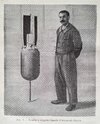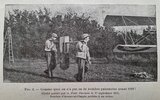Yes, with from right to left a rarely seen 75mm bomb with a tail cone of uncommon shape (not the 75mm Michelin, may be a local built), a 90mm Frag "obus empenne" (often called in the operational reports "bombe de 10kg" to differentiate it from the regular explosive "90mm obus enpenne"), a Gros-Andreau 120mm Anilite bomb, a 90mm shell with an added tai (not the regular "obus empenne de 90" - here too, may be a local build? ) , and this 130mm incendiary bomb.
The presence of these uncommon projectiles leads me to think that this was taken in Saloniki - On the Gallipoli peninsula you had, by a strange coincidence, both the British and the French CO of the local small squadrons (that soon became for all practical means a single mixed squadron) being the leading experts in their respective countries, of the development of air-dropped ordnance: Perrin (Pierre Perrin de Brichambaut
) and Samson (Charles Rumney Samson).
BTW Perrin, while at the MF8 Squadron, had already built and dropped on July 14th, 1915 an incendiary device made of 4 aircraft fuel cans around a 10kg shell....something that will reappear in his squadron in Saloniki in an upgraded form (see a recent thread here).
Here is a pic of Samson and members of the 3rd RNAS squadron on Gallipoli peninsula in Dec 1915, displaying in the center the 500lb bomb they tested there (and that would become after that a regular piece of RNAS ordnance, the 550lb HE RL MKI, being produced and used till the late 1930s)

and here under Samson's Farman 27 before take off from Mudros
























